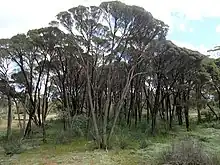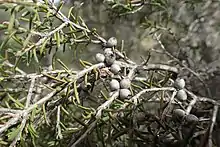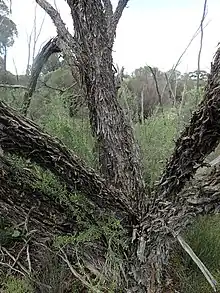| Melaleuca adenostyla | |
|---|---|
 | |
| Near Hyden | |
| Scientific classification | |
| Kingdom: | Plantae |
| Clade: | Tracheophytes |
| Clade: | Angiosperms |
| Clade: | Eudicots |
| Clade: | Rosids |
| Order: | Myrtales |
| Family: | Myrtaceae |
| Genus: | Melaleuca |
| Species: | M. adenostyla |
| Binomial name | |
| Melaleuca adenostyla K.J.Cowley[1] | |


Melaleuca adenostyla is a plant in the myrtle family, Myrtaceae and is endemic to the south-west of Western Australia. It is a large, broom-like shrub to about 5 metres (16 ft) high with narrow leaves and cream-coloured flowers and which often grows in saline places.
Description
Melaleuca adenostyla is a shrub growing to about 5 m (20 ft) tall with mostly glabrous leaves and branches. The leaves are arranged in alternating pairs (decussate) and are 6–16 mm (0.2–0.6 in) long, 0.8–1.2 mm (0.03–0.05 in) wide, and linear or narrow elliptic in shape.[2]
The flowers are cream coloured and arranged in a spike at the ends of branches which continue to grow after flowering. Each spike contains between one and 12 individual flowers and is up to 18 mm (0.7 in) in diameter. The petals are 1.8–2.4 mm (0.07–0.09 in) long and fall off as the flower ages. The stamens are arranged in five bundles around the flower, each bundle containing 11 to 21 stamens. Flowering occurs in spring and is followed by fruit which are woody capsules 3.5–4 mm (0.1–0.2 in) long and partly buried in the branches.[2][3]
Melaleuca adenostyla resembles M. platycalyx except that the latter is somewhat smaller, has pinkish to mauve-coloured flowers and more (25-36) stamens in each bundle. M. adenostyla flowers have 11-21 stamens for each of its five bundles compared to 25-36 for M. platycalyx. The leaves of M. adenostyla are also narrower than those of M. platycalyx.[3]
Taxonomy and naming
Melaleuca adenostyla was first formally described in 1999 by Kirsten Cowley in a review of Melaleuca fulgens from a specimen collected near Hyden.[4][5] The specific epithet (adenostyla) means "glandular style".[6]
Distribution and habitat
This melaleuca occurs in the Avon Wheatbelt and Mallee biogeographic regions of Western Australia[7] from Dumbleyung east to the Hyden-Newdegate region of Western Australia.[3] It grows in white or gravelly sand in saline floodways and depressions.[8]
Conservation status
This species is classified as "not threatened" by the Government of Western Australia Department of Parks and Wildlife.[7]
References
- ↑ Cowley, Kirsten. "Melaleuca adenostyla". Australian Plant Census. Retrieved 4 July 2019.
- 1 2 Brophy, Joseph J.; Craven, Lyndley A.; Doran, John C. (2013). Melaleucas : their botany, essential oils and uses. Canberra: Australian Centre for International Agricultural Research. p. 69. ISBN 9781922137517.
- 1 2 3 Holliday, Ivan (2004). Melaleucas : a field and garden guide (2nd ed.). Frenchs Forest, N.S.W.: Reed New Holland Publishers. p. 216. ISBN 1876334983.
- ↑ Cowley, K.J.; Quinn, F.C.; Barlow, B.A.; Craven, L.A. (1990). "Contributions to a revision of Melaleuca (Myrtaceae): 7–10". Australian Systematic Botany. 3 (5): 165–202. doi:10.1071/SB9900165. Retrieved 4 March 2015.
- ↑ "Melaleuca adenostyla". APNI. Retrieved 29 April 2015.
- ↑ Sharr, Francis Aubi; George, Alex (2019). Western Australian Plant Names and Their Meanings (3rd ed.). Kardinya, WA: Four Gables Press. p. 127. ISBN 9780958034180.
- 1 2 "Melaleuca adenostyla K.J.Cowley". FloraBase. Western Australian Government Department of Biodiversity, Conservation and Attractions.
- ↑ Paczkowska, Grazyna; Chapman, Alex R. (2000). The Western Australian flora : a descriptive catalogue. Perth: Wildflower Society of Western Australia. ISBN 0646402439.